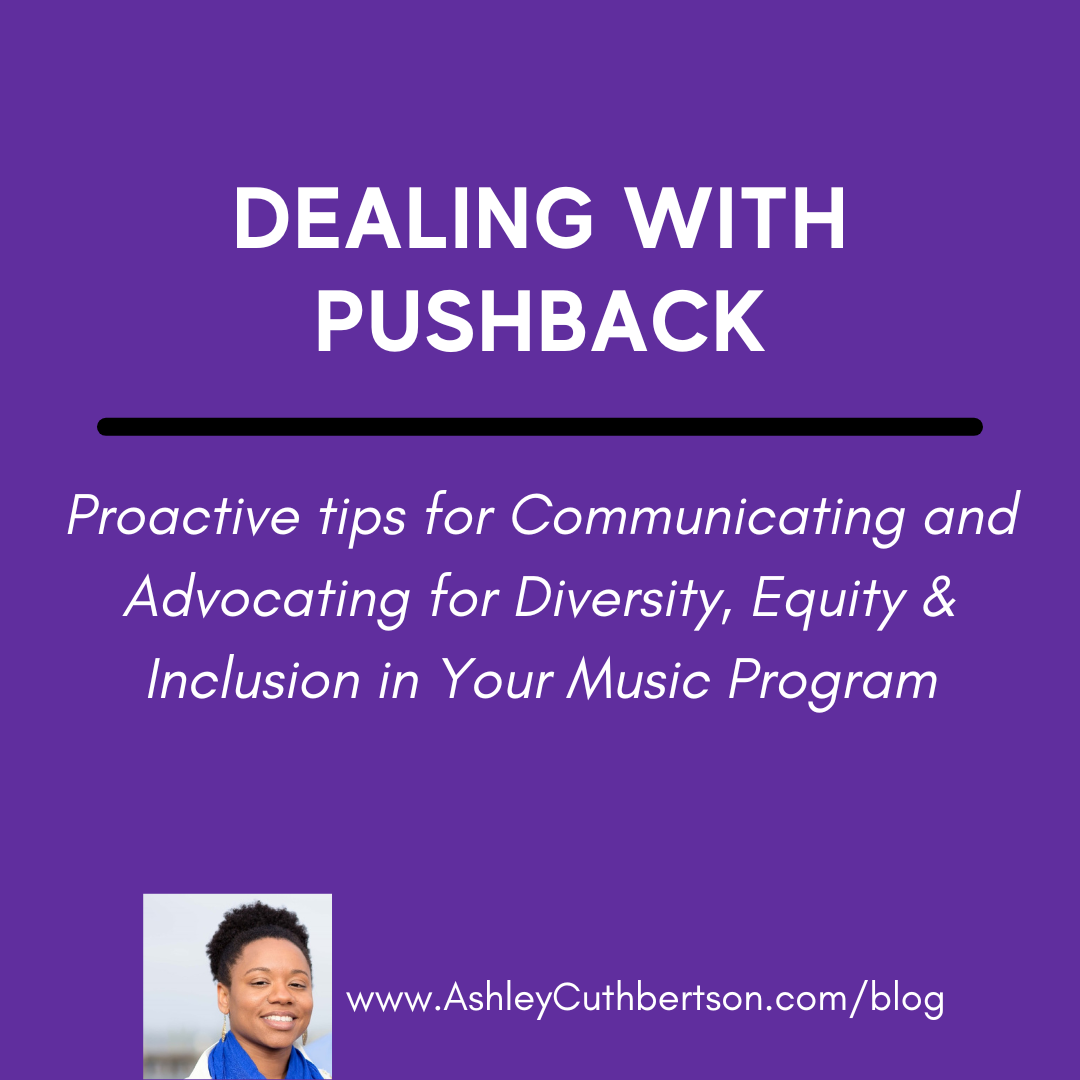Listen to this blog post by clicking the player below!
As music educators committed to diversity, equity, and inclusion, it’s important to point out that there will be pushback. We must expect it and we must be ready for it. As with any kind of change, there will be discomfort, and in fact when there is discomfort that is how we know that we are moving forward.
This push back may come from colleagues, administrators, students, and/or families. Remember that not everyone is in the same place in their journey towards equity, and much of their pushback may simply be coming from a place of misunderstanding and confusion.
Unfortunately, in our current times and political climate, many folks are confused and misunderstand phrases and terms such as ‘culture’, ‘culturally responsive’, ‘diversity, equity, and inclusion.’
Music educators can mitigate potential pushback by being proactive, and thus be able to continue to advocate for a diverse, equitable, and inclusive music education for all of our learners.
Today, here are a four tips for how to be proactive about communicating and advocating for diversity, equity, and inclusion in your music program.
Tip #1: Seek to Understand Your School Community
Music educators can be better positioned to speak on what possible concerns may arise from colleagues, administrators, students, and families by first seeking to understand their school community.
Be aware of what expectations folks may already have, and then proactively plan for how you can address those expectations while also advocating for diverse, inclusive, and equitable learning for all of your music students.
Seek out key stakeholders in your school community to discuss and share with so that you can better understand where others are coming from and how you might want to proceed.
Tip #2: Share the Mission & Goals of the School Music Program
First, you need to have a clear mission and goals statement for your school music program that clearly articulates the importance of diversity, equity, and inclusion. Then you need to share it!
Be proactive in sharing the overall mission of the school’s music program and make it clear that selecting diverse music that represents a wide range of cultures, identities, and histories is an important part of the educational goals. Be clear that you aim to provide an equitable music learning experience for all students and include things that folks may expect to see and why.
Tip #3: Use plain language & make standards-based choices
Use plain language to communicate repertoire context as well as the music standards addressed in your lessons, and educational purposes of any repertoire and/or musical materials.
The National Association for Music Education (NAfME) has amassed numerous resources to support diversity, equity, inclusion, and access in music education including articles, books, on-demand webinars to support music educators understandings around equity as well as advocacy. Additionally, NAfME has shared clear position statements for Equity and Access as well as Inclusivity and Diversity in music education that can be used to support advocacy.
Tip #4: Always do your research & provide context for the repertoire you choose to teach (and what you choose not to teach)
When teaching any piece of repertoire, we must share the context including who created it, what it is about, it’s purpose, and why it has been selected for learning. This does not require for music educators to be experts on any specific piece or genre, but it does require that music educators be well-informed so that they can effectively communicate their choices.
When communicating with students specifically, consider what language to use in order to communicate in a way that is truthful and age-appropriate. One particularly useful resource for what language to use for young children is the work of Akiea “Ki” Gross and their pedagogy, Woke Kindergarten. Additionally, as students engage with a piece of music over time, consider how the contextual information can be shared in bite-sized chunks over time, rather than all at once.
When communicating with colleagues, administrators, and families, having research ready becomes even more important. As I mentioned above, oftentimes pushback comes from misunderstanding and confusion. Having contextual information that’s supported by research ready to share can often mitigate those misunderstandings and confusion.
For example, many music educators are rightfully removing “Jingle Bells” from their repertoire due to it’s ties to black face minstrelsy. Because “Jingle Bells” is such a prevalent song in U.S. culture, and many are unaware of it’s ties to minstrelsy, simply removing it without giving explanation can cause a lot of confusion and upset. In cases such as this one, expect that there will be pushback and proactively be prepared to confidently explain why you are removing this song and have the research ready to share as well.
What other tips would you add?
I would love to hear your thoughts about what other tips you would suggest for communicating and advocating for diversity, equity, and inclusion in school music programs.
Share below or share on social media and tag me: I’m @ACuthbertson10 on Twitter & Instagram, and @ACuthbertsonConsulting on Facebook.
Also, let me know what you think of this post! If you haven’t already, be sure to sign up for my email newsletter where I send blog posts and other music ed resources and tips each week to help support you ensure all of your young musicians thrive.
Until next time,
Ashley
P.S. Did you like this post? Use the buttons below to share it with a music teacher friend!
